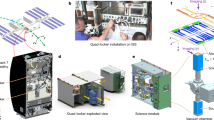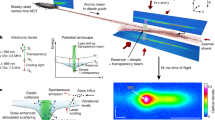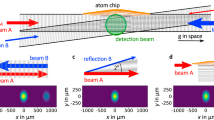Abstract
Some of the most sensitive and precise measurements—for example, of inertia1, gravity2 and rotation3—are based on matter-wave interferometry with free-falling atomic clouds. To achieve very high sensitivities, the interrogation time has to be very long, and consequently the experimental apparatus needs to be very tall (in some cases reaching ten or even one hundred metres) or the experiments must be performed in microgravity in space4,5,6,7. Cancelling gravitational acceleration (for example, in atomtronic circuits8,9 and matter-wave guides10) is expected to result in compact devices with extended interrogation times and therefore increased sensitivity. Here we demonstrate smooth and controllable matter-wave guides by transporting Bose–Einstein condensates (BECs) over macroscopic distances. We use a neutral-atom accelerator ring to bring BECs to very high speeds (16 times their sound velocity) and transport them in a magnetic matter-wave guide for 15 centimetres while fully preserving their internal coherence. The resulting high angular momentum of more than 40,000ħ per atom (where ħ is the reduced Planck constant) gives access to the higher Landau levels of quantum Hall states, and the hypersonic velocities achieved, combined with our ability to control potentials with picokelvin precision, will facilitate the study of superfluidity and give rise to tunnelling and a large range of transport regimes of ultracold atoms11,12,13. Coherent matter-wave guides are expected to enable interaction times of several seconds in highly compact devices and lead to portable guided-atom interferometers for applications such as inertial navigation and gravity mapping.
This is a preview of subscription content, access via your institution
Access options
Access Nature and 54 other Nature Portfolio journals
Get Nature+, our best-value online-access subscription
$29.99 / 30 days
cancel any time
Subscribe to this journal
Receive 51 print issues and online access
$199.00 per year
only $3.90 per issue
Buy this article
- Purchase on Springer Link
- Instant access to full article PDF
Prices may be subject to local taxes which are calculated during checkout



Similar content being viewed by others
Data availability
The data that support the findings of this study are available from the corresponding author upon reasonable request.
References
Geiger, R. et al. Detecting inertial effects with airborne matter-wave interferometry. Nat. Commun. 2, 474 (2011).
Rosi, G., Sorrentino, F., Cacciapuoti, L., Prevedelli, M. & Tino, G. M. Precision measurement of the Newtonian gravitational constant using cold atoms. Nature 510, 518–521 (2014).
Dutta, I. et al. Continuous cold-atom inertial sensor with 1 nrad/sec rotation stability. Phys. Rev. Lett. 116, 183003 (2016).
Kovachy, T. et al. Quantum superposition at the half-metre scale. Nature 528, 530–533 (2015).
van Zoest, T. et al. Bose–Einstein condensation in microgravity. Science 328, 1540–1543 (2010).
Barrett, B. et al. Dual matter-wave inertial sensors in weightlessness. Nat. Commun. 7, 13786 (2016).
Soriano, M. et al. Cold atom laboratory mission system design. In 2014 IEEE Aerospace Conference 1–11 (IEEE, 2014).
Amico, L., Birkl, G., Boshier, M. & Kwek, L.-C. Focus on atomtronics-enabled quantum technologies. New J. Phys. 19, 020201 (2017).
Dumke, R. et al. Roadmap on quantum optical systems. J. Opt. 18, 093001 (2016).
Wang, Y. J. et al. Atom Michelson interferometer on a chip using a Bose–Einstein condensate. Phys. Rev. Lett. 94, 090405 (2005).
Brantut, J.-P., Meineke, J., Stadler, D., Krinner, S. & Esslinger, T. Conduction of ultracold fermions through a mesoscopic channel. Science 337, 1069–1071 (2012).
Krinner, S., Esslinger, T. & Brantut, J.-P. Two-terminal transport measurements with cold atoms. J. Phys. Condens. Matter 29, 343003 (2017).
Krinner, S., Stadler, D., Husmann, D., Brantut, J.-P. & Esslinger, T. Observation of quantized conductance in neutral matter. Nature 517, 64–67 (2015).
Lenef, A. et al. Rotation sensing with an atom interferometer. Phys. Rev. Lett. 78, 760–763 (1997).
Lesanovsky, I. & von Klitzing, W. Spontaneous emergence of angular momentum josephson oscillations in coupled annular bose-einstein condensates. Phys. Rev. Lett. 98, 050401 (2007).
Eckel, S. et al. Hysteresis in a quantized superfluid ‘atomtronic’ circuit. Nature 506, 200–203 (2014).
Murch, K. W., Moore, K. L., Gupta, S. & Stamper-Kurn, D. M. Dispersion management using betatron resonances in an ultracold-atom storage ring. Phys. Rev. Lett. 96, 013202 (2006).
Navez, P. et al. Matter-wave interferometers using TAAP rings. New J. Phys. 18, 075014 (2016).
Henderson, K., Ryu, C., MacCormick, C. & Boshier, M. G. Experimental demonstration of painting arbitrary and dynamic potentials for Bose–Einstein condensates. New J. Phys. 11, 043030 (2009).
Ryu, C. et al. Observation of persistent flow of a Bose–Einstein condensate in a toroidal trap. Phys. Rev. Lett. 99, 260401 (2007).
Leanhardt, A. E. et al. Propagation of Bose–Einstein condensates in a magnetic waveguide. Phys. Rev. Lett. 89, 040401 (2002).
Trebbia, J.-B., Garrido Alzar, C. L., Cornelussen, R., Westbrook, C. I. & Bouchoule, I. Roughness suppression via rapid current modulation on an atom chip. Phys. Rev. Lett. 98, 263201 (2007).
Chen, X., Torrontegui, E., Stefanatos, D., Li, J.-S. & Muga, J. G. Optimal trajectories for efficient atomic transport without final excitation. Phys. Rev. A 84, 043415 (2011).
Guéry-Odelin, D. & Muga, J. G. Transport in a harmonic trap: shortcuts to adiabaticity and robust protocols. Phys. Rev. A 90, 063425 (2014).
Jones, M. P. A. et al. Cold atoms probe the magnetic field near a wire. J. Phys. B 37, L15 (2004).
Folman, R. et al. Controlling cold atoms using nanofabricated surfaces: atom chips. Phys. Rev. Lett. 84, 4749–4752 (2000).
Lesanovsky, I. & von Klitzing, W. Time-averaged adiabatic potentials: versatile matter-wave guides and atom traps. Phys. Rev. Lett. 99, 083001 (2007).
Sherlock, B. E., Gildemeister, M., Owen, E., Nugent, E. & Foot, C. J. Time-averaged adiabatic ring potential for ultracold atoms. Phys. Rev. A 83, 043408 (2011).
Zobay, O. & Garraway, B. M. Two-dimensional atom trapping in field-induced adiabatic potentials. Phys. Rev. Lett. 86, 1195–1198 (2001).
Müller, J. H. et al. Atomic micromotion and geometric forces in a triaxial magnetic trap. Phys. Rev. Lett. 85, 4454–4457 (2000).
Kumar, A. et al. Minimally destructive, Doppler measurement of a quantized flow in a ring-shaped Bose–Einstein condensate. New J. Phys. 18, 025001 (2016).
Roncaglia, M., Rizzi, M. & Dalibard, J. From rotating atomic rings to quantum Hall states. Sci. Rep. 1, 43 (2011).
Lin, Y.-J., Perry, A. R., Compton, R. L., Spielman, I. B. & Porto, J. V. Rapid production of 87Rb Bose–Einstein condensates in a combined magnetic and optical potential. Phys. Rev. A 79, 063631 (2009).
Pappa, M. et al. Ultra-sensitive atom imaging for matter-wave optics. New J. Phys. 13, 115012 (2011).
Petrov, D. S., Shlyapnikov, G. V. & Walraven, J. T. M. Phase-fluctuating 3D Bose–Einstein condensates in elongated traps. Phys. Rev. Lett. 87, 050404 (2001).
Dettmer, S. et al. Observation of phase fluctuations in elongated Bose–Einstein condensates. Phys. Rev. Lett. 87, 160406 (2001).
Kavoulakis, G. M. & Pethick, C. J. Quasi-one-dimensional character of sound propagation in elongated Bose–Einstein condensed clouds. Phys. Rev. A 58, 1563–1566 (1998).
Acknowledgements
This work is supported by the project HELLAS-CH (MIS 5002735), which is implemented under the Action for Strengthening Research and Innovation Infrastructures, funded by the Operational Programme 'Competitiveness, Entrepreneurship and Innovation' (NSRF 2014-2020) and co-financed by Greece and the European Union (European Regional Development Fund). G.V. received funding from the European Commission’s Horizon 2020 research and innovation programme under the Marie Skłodowska-Curie Grant Agreement 750017. S.P. and G.D. acknowledge financial support from the Hellenic Foundation for Research and Innovation (HFRI) and the General Secretariat and Technology (GSRT), under the HFRI PhD Fellowship grants 4823 and 4794.
Author information
Authors and Affiliations
Contributions
W.v.K. conceived the ideas for the experiments. S.P., H.M. and W.v.K. carried out the experiments, data analysis and theoretical work. S.P., H.M., K.P., V.B., G.D. and W.v.K. built the experiment. All authors contributed to the discussion of the results and writing of the manuscript.
Corresponding author
Ethics declarations
Competing interests
The authors declare no competing interests.
Additional information
Publisher’s note: Springer Nature remains neutral with regard to jurisdictional claims in published maps and institutional affiliations.
Rights and permissions
About this article
Cite this article
Pandey, S., Mas, H., Drougakis, G. et al. Hypersonic Bose–Einstein condensates in accelerator rings. Nature 570, 205–209 (2019). https://doi.org/10.1038/s41586-019-1273-5
Received:
Accepted:
Published:
Issue Date:
DOI: https://doi.org/10.1038/s41586-019-1273-5
This article is cited by
-
Low-dimensional quantum gases in curved geometries
Nature Reviews Physics (2023)
-
Can the double-slit experiment distinguish between quantum interpretations?
Communications Physics (2023)
-
Probe for bound states of SU(3) fermions and colour deconfinement
Communications Physics (2023)
-
Many-Body State and Dynamic Behaviour of the Pair-Correlation Function of a Small Bose–Einstein Condensate Confined in a Ring Potential
Journal of Low Temperature Physics (2023)
-
Multifaceted phase ordering kinetics of an antiferromagnetic spin-1 condensate
Scientific Reports (2021)
Comments
By submitting a comment you agree to abide by our Terms and Community Guidelines. If you find something abusive or that does not comply with our terms or guidelines please flag it as inappropriate.



